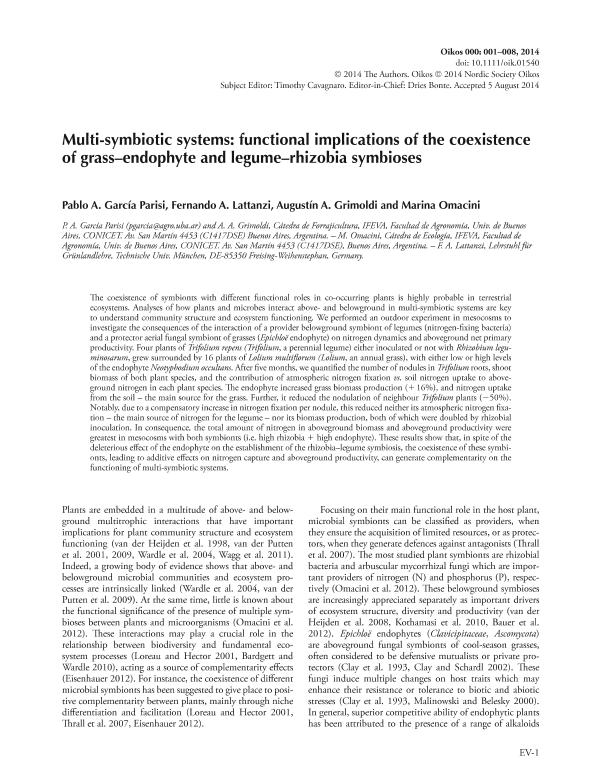Mostrar el registro sencillo del ítem
dc.contributor.author
Garcia Parisi, Pablo Adrian

dc.contributor.author
Lattanzi, Fernando Alfredo
dc.contributor.author
Grimoldi, Agustin Alberto

dc.contributor.author
Omacini, Marina

dc.date.available
2016-02-16T19:51:11Z
dc.date.issued
2014-10
dc.identifier.citation
Garcia Parisi, Pablo Adrian; Lattanzi, Fernando Alfredo; Grimoldi, Agustin Alberto; Omacini, Marina; Multi-symbiotic systems: functional implications of the coexistence of grass-endophyte and legume-rhizobia symbioses; Wiley; Oikos; 124; 5; 10-2014; 553-560
dc.identifier.issn
0030-1299
dc.identifier.uri
http://hdl.handle.net/11336/4209
dc.description.abstract
The coexistence of symbionts with different functional roles in co-occurring plants is highly probable in terrestrial ecosystems. Analyses of how plants and microbes interact above- and belowground in multi-symbiotic systems are key to understand community structure and ecosystem functioning. We performed an outdoor experiment in mesocosms to investigate the consequences of the interaction of a provider belowground symbiont of legumes (nitrogen-fixing bacteria) and a protector aerial fungal symbiont of grasses (Epichloё endophyte) on nitrogen dynamics and aboveground net primary productivity. Four plants of Trifolium repens (Trifolium, a perennial legume) either inoculated or not with Rhizobium leguminosarum, grew surrounded by 16 plants of Lolium multiflorum (Lolium, an annual grass), with either low or high levels of the endophyte Neotyphodium occultans. After five months, we quantified the number of nodules in Trifolium roots, shoot biomass of both plant species, and the contribution of atmospheric nitrogen fixation vs. soil nitrogen uptake to above ground nitrogen in each plant species. The endophyte increased grass biomass production (+ 16%), and nitrogen uptake from the soil – the main source for the grass. Further, it reduced the nodulation of neighbour Trifolium plants (−50%). Notably, due to a compensatory increase in nitrogen fixation per nodule, this reduced neither its atmospheric nitrogen fixation – the main source of nitrogen for the legume – nor its biomass production, both of which were doubled by rhizobial inoculation. In consequence, the total amount of nitrogen in aboveground biomass and aboveground productivity were greatest in mesocosms with both symbionts (i.e. high rhizobia + high endophyte). These results show that, in spite of the deleterious effect of the endophyte on the establishment of the rhizobia–legume symbiosis, the coexistence of these symbionts, leading to additive effects on nitrogen capture and aboveground productivity, can generate complementarity on the functioning of multi-symbiotic systems.
dc.format
application/pdf
dc.language.iso
eng
dc.publisher
Wiley

dc.rights
info:eu-repo/semantics/openAccess
dc.rights.uri
https://creativecommons.org/licenses/by-nc-sa/2.5/ar/
dc.subject
Neotyphodium
dc.subject
Rhizobium
dc.subject
Symbiosis
dc.subject
Nitrogen Fixation
dc.subject
Nitrogen Dynamics
dc.subject
Mutualisms
dc.subject
Ecosystem Functioning
dc.subject.classification
Ecología

dc.subject.classification
Ciencias Biológicas

dc.subject.classification
CIENCIAS NATURALES Y EXACTAS

dc.title
Multi-symbiotic systems: functional implications of the coexistence of grass-endophyte and legume-rhizobia symbioses
dc.type
info:eu-repo/semantics/article
dc.type
info:ar-repo/semantics/artículo
dc.type
info:eu-repo/semantics/publishedVersion
dc.date.updated
2016-03-30 10:35:44.97925-03
dc.journal.volume
124
dc.journal.number
5
dc.journal.pagination
553-560
dc.journal.pais
Estados Unidos

dc.journal.ciudad
Hoboken
dc.description.fil
Fil: Garcia Parisi, Pablo Adrian. Consejo Nacional de Investigaciones Científicas y Técnicas. Oficina de Coordinación Administrativa Parque Centenario. Instituto de Investigaciones Fisiológicas y Ecológicas Vinculadas a la Agricultura; Argentina
dc.description.fil
Fil: Lattanzi, Fernando Alfredo. Technische Universität. Lehrstuhl für Grünlandlehre; Alemania
dc.description.fil
Fil: Grimoldi, Agustin Alberto. Consejo Nacional de Investigaciones Científicas y Técnicas. Oficina de Coordinación Administrativa Parque Centenario. Instituto de Investigaciones Fisiológicas y Ecológicas Vinculadas a la Agricultura; Argentina
dc.description.fil
Fil: Omacini, Marina. Consejo Nacional de Investigaciones Científicas y Técnicas. Oficina de Coordinación Administrativa Parque Centenario. Instituto de Investigaciones Fisiológicas y Ecológicas Vinculadas a la Agricultura; Argentina
dc.journal.title
Oikos

dc.relation.alternativeid
info:eu-repo/semantics/altIdentifier/url/http://onlinelibrary.wiley.com/doi/10.1111/oik.01540/abstract
dc.relation.alternativeid
info:eu-repo/semantics/altIdentifier/issn/0030-1299
dc.relation.alternativeid
info:eu-repo/semantics/altIdentifier/doi/http://dx.doi.org/DOI:10.1111/oik.01540
Archivos asociados
